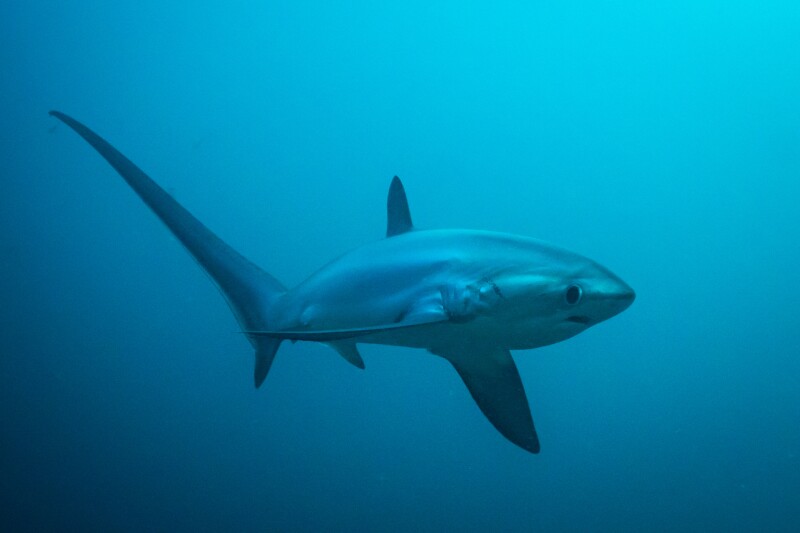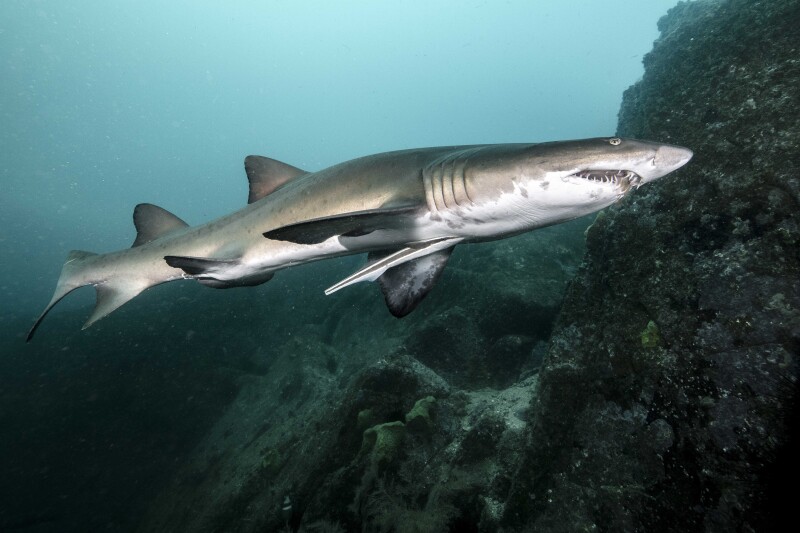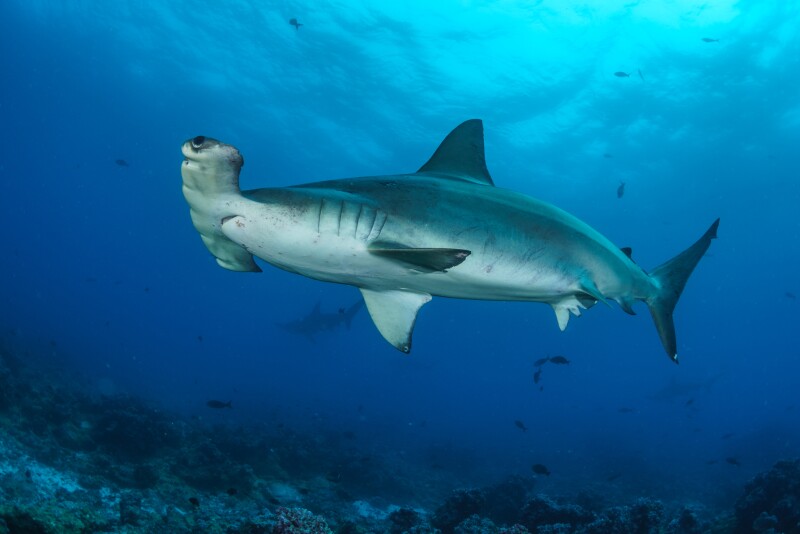“Any scuba diver will tell you that, far from being the terrifying human-munching death machines you see in the movies, most sharks couldn’t be less interested in people. In fact, they often purposefully avoid them,” says Dr. Simon J. Pierce, cofounder of the marine conservation charity Marine Megafauna Foundation (MMF) and all-around shark fan.
Like Dr. Pierce, many people are willing to travel across the globe to see these fascinating fish in their natural habitats. While each of the more than 400 different species of shark is unique in its own way, most are safe to interact with—a fact that is reassuring to anyone hoping to scuba dive or snorkel with them, or even just spot them from a boat. Sadly 31 percent of all sharks and rays are threatened with extinction, according to global conservation authority the International Union for Conservation of Nature (IUCN). So, if you want to brave some of the world’s most incredible shark sightings and learn more about these curious creatures now, here’s where to go.

Whale sharks eat plankton and fish eggs and are harmless to humans.
Photo by Simon J Pierce
To see: Whale Sharks
Go to: Madagascar, Mexico, and Mozambique
Conservation Status: Endangered“Whale sharks are massive, spotty and—let’s face it—thoroughly endearing,” says Dr. Pierce. The world’s largest shark, which feeds on plankton and fish eggs, is totally harmless to humans and will sometimes even check out or play with visitors. Because they tend to feed in shallow coastal aggregations, it’s possible to snorkel with whale sharks: Head to destinations such as Nosy Be in Madagascar, which the Madagascar Whale Shark Project recently identified as a feeding hot spot for juveniles; Isla Mujeres in Mexico, home to one of the world’s largest aggregations of whale sharks (you might see 100 individuals in one day!); or Tofo Beach in Mozambique, where MMF researchers often go out on the boats during Peri-Peri Divers dive trips to study these enigmatic animals.

Basking sharks glide just below the sea surface to feed.
Photo by David Robinson
To see: Basking Sharks
Go to: The United Kingdom
Conservation Status: Vulnerable to ExtinctionAccording to the Marine Conservation Society (MCS), basking sharks are so called because “in summer months, when we are most likely to see them, [they] move slowly at the sea surface, feeding on plankton with their characteristic wide-gaped open mouths. This gives the impression they are basking in the sun.” Thanks to MCS lobbying, these sharks are now protected in U.K. waters. Between the months of April and October, join one of the many shark-watching boat trips in southwest Cornwall, around the Isle of Man, or along the west coast of Scotland to spot one of these large, calm creatures.

Don’t be fooled by the thresher’s worried look.
Photo by Simon J Pierce
To see: Pelagic Thresher Sharks
Go to: Malapascua, Philippines
Conservation Status: Vulnerable to ExtinctionDr. Pierce likes to describe threshers as “deceptively violent ninja sharks.” That’s because, he says, “Although these sharks tend to have quite a concerned look on their face in pictures, they’re deadly to their prey.” In a school of fish, it is difficult for sharks to pick out individuals to hunt, but the thresher shark has developed an ingenious hunting strategy. Pummeling forward into the school, it uses its oversized tail to whip through the water, killing several fish with a single blow. The only place these graceful sharks are seen consistently is Monad Shoal, off Malapascua Island in the Philippines. First thing in the morning, threshers visit “cleaning stations” along the reef—areas inhabited by the tiny fish that clean the sharks by eating their dead skin and bacteria—before returning to much deeper waters for the rest of the day, so you’ll have to get up at dawn to spot them.

The only safe way to dive with great white sharks is with a cage.
Photo by David Robinson
To see: Great White Sharks
Go to: Gansbaai, South Africa
Conservation Status: Vulnerable to ExtinctionCage diving—the only way to see great whites safely—is controversial because many operators bait the sharks to bring them in for a closer encounter, which some have claimed is linked to a rise in shark attacks. That’s why it’s important to choose a responsible operator like White Shark Projects, an organization in South Africa that is dedicated to the conservation of this oceanic apex predator. It offers what it refers to as “an adrenaline-surging adventure experience” where you can admire “these gliding torpedoes of power” while also learning about the species and the things that can be done to help their conservation.

Dive with bull sharks in the diverse ecosystem of Shark Reef Marine Reserve in Fiji.
Photo by David Robinson
To see: Bull Sharks
Go to: Fiji
Conservation Status: Near Threatened“Bull sharks are one of the few fish that can transition through ecosystems occupying fresh water, brackish water, and saltwater. [They survive] just as well in the open ocean as they do in lagoons and murky river waters,” explains shark scientist Lukas Mueller. A great destination for keen shark divers, Shark Reef Marine Reserve became Fiji’s first protected marine park in 2014. Beqa Adventure Divers worked closely with the Fijian government to make this happen and is now responsible for the management of the park. When diving with the company’s expert crew, you’ll have the opportunity to see not only bull sharks but several other species too, including blacktip and whitetip reef sharks, grey reef sharks, tawny nurse sharks, and even—if you’re lucky—tiger sharks.
Marine biologist David Robinson, chief scientist at Sharkwatch Arabia, recalls diving with bull sharks in Fiji: “[They] are magnificent creatures, and getting the chance to dive with them in clear water was a dream come true. It was fantastic to be able to observe the animals in the wild and see how they carefully interact with the divers and handlers in such a controlled manner. Beqa lagoon is a very special place and should be on everyone’s shark dive bucket list.”

Grey nurse sharks look intimidating, but they’re actualy gentle.
Photo by David Robinson
To see: Grey Nurse Sharks
Go to: Byron Bay, Australia
Conservation Status: Critically EndangeredThese ragged-tooth sharks might look ferocious, but despite their size (grey nurse sharks can grow up to 350 pounds), they are docile and unlikely to harm humans. Unlike other sharks, which stay buoyant with an organ called a swim bladder, “raggies” gulp down large amounts of air that they store in their stomach so they don’t sink. You can try to spot these peaceful sharks with Sundive at the biodiverse Julian Rocks Marine Reserve.

Scalloped hammerhead sharks gather in schools of several hundred in the Galápagos.
Photo by Simon J Pierce
To see: Scalloped Hammerhead Sharks
Go to: Darwin Arch and Wolf Island, Galápagos
Conservation Status: EndangeredHead to the (actual) Galápagos Marine Reserve to see one of the most distinctive and iconic species of shark—the hammerhead. According to the Galapagos Conservation Trust, scalloped hammerheads gather in schools of up to several hundred here, and it’s one of the few places on Earth where they do so. While the reason for this remains a mystery, the fantastic spectacle is something you’ll remember for a lifetime.
>>Next: Yes, You Can Help Save Endangered Species on Your Next Trip











